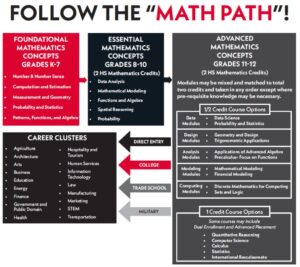
by James C. Sherlock
The problem Virginia Department of Education Virginia Mathematics Pathways Initiative (VMPI) and associated equity changes are designed to solve is low math proficiency among black students.
That math performance issue must be addressed beginning in kindergarten and before. At the end of the 3rd grade, even under Virginia’s new standards, every child is supposed to know how to multiply and to read. Both in math and reading, a child’s proficiency at the end of the third grade has proven in study after study to provide a key indicator of his or her academic performance going forward.
The top 20 Fairfax County elementary schools ranked (by me using state data) by black student 2028-19 math SOL pass rate achieved a pass rate within that demographic of 96.5. In the bottom 20 schools in that same county, the mean black student pass rate was 52.5. See link to spreadsheet.
Those schools offer an excellent opportunity to examine whether VMPI and other equity changes proposed or adopted by VDOE will address those enormous differences in black student math education outcomes.
The VMPI model and other VBOE changes meant to improve math outcomes are generally composed of:
- curriculum overhaul
- scoring methodology changes
- retraining of math teachers in both the new syllabus and cultural awareness
- elimination of tracking
- elimination of “high stakes” testing
- changing the race mix of teachers to match the demographics of the students
Those changes are proffered as a way to lift all boats.
If that is true, then I suggest those factors should be proven to be contributing factors to the enormous differentials in black math performance among individual elementary schools in Fairfax County.
Using schools with a kindergarten also eliminates magnet schools from the data in any assessment.
I have reviewed elementary school math SOL scores by school subject area for the last year they were given, 2018-2019 .
I took a list of those schools, eliminated all but those with a kindergarten, sorted for black student math pass rate, and was left with 956 Virginia elementary schools meeting the criteria, 133 of which are in Fairfax County.
Again, in order to both reduce variables of place and retain a sufficient numbers to be statistically significant, I will use as my example Fairfax County schools only.
I ask for those 40 schools to be assessed to see if VMPI and associated equity changes are likely to measurably improve the math scores of black students in the bottom 20 schools, and, if it does so, without negatively affecting the scores of the black children in the top 20 schools.
We need to ask a set of questions structured to help understand the stunning variability in performances of black children and the factors in those differences in both sets of schools. Some factors to be assessed for importance include:
- Curriculum. Hard to see how it could be. Fairfax County Schools have the same PK-6 curriculum systemwide.
- Systemic racism. Hard to say that a school system that produces the performances in the top 20 is systemically racist by this measure.
- Relative teacher quality/experience. Possibly.
- Teacher turnover traceable to pay and satisfaction with the teaching environment.
- Cultural attitudes/racism by individual teachers. If so, they appear to be concentrated in the bottom 20.
- School leadership quality.
- Teacher demographics. There are common assertions that suggest that black students do better if they have a black teacher. Do the black children in the top 20 schools have more black math teachers than those in the bottom 20?
- Classroom learning environment. Are there measurable differences that matter?
- Poverty. Most likely. At the class level rather than individual cases, it usually is a factor.
- Methods of scoring. Again, presumably the same at the top 20 and bottom 20 schools, but check it out.
- Home environment other than poverty. Parental education levels? Single parent? Drug and alcohol abuse in the home? Foster homes? Homeless? Incarceration of a parent? Mental illness? Community support structures? All are possible contributing factors.
- Are the low scores disproportionately concentrated in one gender?
- Chronic absenteeism. Probably.
- Discipline problems. Probably, though these tend to be either less prevalent or less well documented in elementary school than later.
- Tracking. Does not appear to be an issue in the top 20 by this single measure. Perhaps unintended tracking — children arrive at school with differences in early childhood education, cultural and home environment factors and inherited/nurtured learning skills.
- “High stakes” testing. Again, clearly not in the top 20.
- Gang activity.
- Something else?
Though some additional data will need to be collected, much of the analysis can be done from available statistics. Again, the sample size is large enough to be statistically significant and concentrated in area and in a single school system management structure to eliminate those variables.
I ask the Virginia Department of Education to hire a systems engineering and analysis contractor to collect, structure and assess the data for Fairfax County elementary schools and provide the results to all Virginians to help justify VMPI and related changes.
Or not justify them. The changes appear to me to be at best shooting behind the rabbit. If VDOE doesn’t accept the challenge, we will know that they are scared of both the questions and the answers.

Leave a Reply
You must be logged in to post a comment.